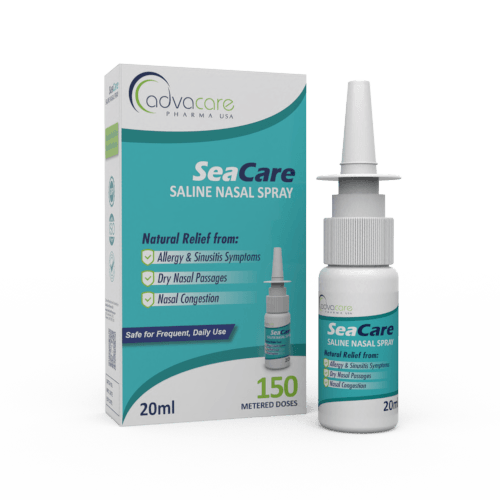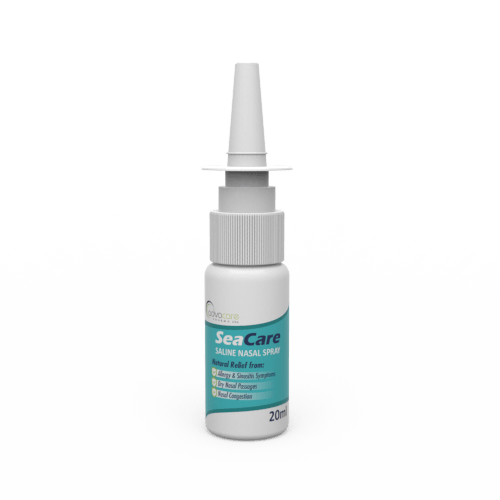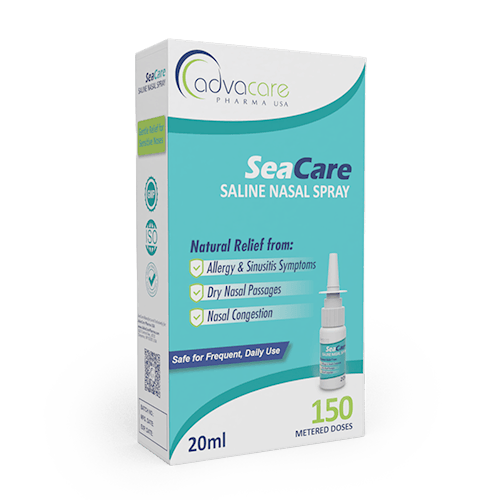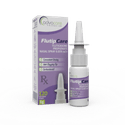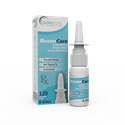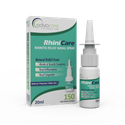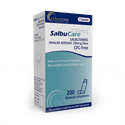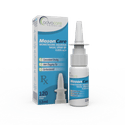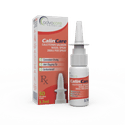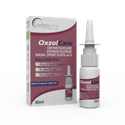- Home›
- Pharmaceuticals›
- Nasal Sprays›
- Saline Nasal Spray
Saline Nasal Spray
Dosage
Packaging
What is Saline Nasal Spray?
Active Ingredients: Sodium Chloride (Saline)
Saline Nasal Spray is a natural, first-line treatment for nasal discomfort caused by colds, allergies, and hay fever. It is also used to relieve sinus congestion and pressure. Saline helps to moisturize dry or irritated nostrils and it acts as nasal irrigation by removing airborne irritants such as pollen and dust.
Saline solution is also recommended after nasal surgeries, as it helps to clear dried blood and crusty mucus from the nasal passage. Saline Nasal Spray is also commonly used by air travelers to alleviate nasal symptoms due to the dry air within a plane.
Intranasal saline is generally well-tolerated by adults and children and it is safe for frequent or daily use. In addition, some preparations are considered safe and gentle for use in babies or young children. Non-medicated saline sprays are commonly used by many people and are typically available for purchase without a prescription at drug stores and pharmacies.
Saline is a sterile purified gentle salt solution, which is composed of sodium chloride and water. Sodium chloride (NaCl) is also known as salt.
The saline solution does not contain any active medications or drugs but may contain buffers or preservatives.
Saline Nasal Spray is produced in two formulations: 0.65% w/v (hypotonic solution) and 0.9% w/v (isotonic solution). Mist spray bottles and metered spray bottles are available for distribution.
AdvaCare Pharma is a manufacturer and supplier of Saline Nasal Spray. Every part of our supply chain is thoroughly vetted to ensure it meets health, safety, and environmental standards. This medication is produced in our GMP-certified facilities in China, India, and the USA.
Why choose us as your Saline Nasal Spray manufacturer?
AdvaCare Pharma, an American pharmaceutical company, manufactures Saline Nasal Spray at our GMP-certified facilities. We are committed to manufacturing more than 500 cost-effective, high-quality medicines that meet the highest industry standards and are readily available to patients worldwide. As an experienced Saline Nasal Spray manufacturer, our global reach extends to over 65 markets where we supply a comprehensive range of 15+ nasal sprays to pharmaceutical distributors, pharmacies, hospitals and government institutions.
Uses
What is Saline used for?
It is used to temporarily relieve congestion and dryness or irritation in the nostrils associated with conditions like allergic rhinitis (including hay fever), the common cold, sinusitis, or treatment with drying medications such as decongestants or steroidal sprays.
Saline spray can be used to flush allergens or dust from nasal passages or temporarily relieve irritated nasal passages due to environmental concerns such as pollution or smoke.
In babies or infants, saline can be used to treat nasal congestion associated with the common cold, influenza, nasal allergies, sinusitis, RSV (respiratory syncytial virus), and other uncomplicated conditions of the upper respiratory system.
The 0.65% preparation of saline is hypotonic. It is primarily used to soften crusty mucus around the nostrils and add moisture to nasal passages. The 0.9 % solution is isotonic and is better suited as a nasal flush or to soften nasal secretions and reduce inflammation of nasal membranes.
Can Saline Nasal Spray be used for sinus infections?
Saline Nasal Spray can be used to help relieve irritation and other symptoms resulting from a sinus infection; however, it will not treat the underlying infection.
Can Saline Nasal Spray be used daily?
This nasal spray is safe to use every day. Since it is a saltwater solution, it can be used daily without harming the nasal tissues or causing rebound congestion. The regular use of Saline Nasal Spray can help prevent symptoms of allergies or the common cold.
How is Saline Nasal Spray used?
This product has been manufactured as a solution that is contained in a mist spray bottle or metered spray bottle. This product is intended for nasal use only. Do not spray into the mouth or eyes.
Before use, it is recommended to thoroughly read the directions on the packaging. In general, when applying saline, the bottle should be squeezed gently in each nostril. Contact with the inside of the nose should be avoided if possible. In the event of contact, the tip of the bottle should be rinsed with hot water and then dried before closing the bottle.
When given to infants, drop application is recommended.
This product should not be shared by more than one person, as this increases the spread of infection.
Do not use this product if the seal has been broken.
How should Saline Nasal Spray be stored?
When not in use, Saline Nasal Spray should be kept tightly sealed and stored at room temperature (below 30°C). Do not store in cold environments such as the refrigerator or a freezer. The bottle should be kept out of the reach of children and pets.
It is recommended to discard any expired bottles. After opening the bottle for the first time, it can be used for up to 6 weeks.
What happens if a dose is missed?
Saline Nasal Spray is typically used on an as-needed basis. If there is a dosing schedule, if it is nearly time for the next dose, the missed dose should be skipped. Two doses should not be administered at the same time.
What dose should be taken?
Adult Dosing Dosage may vary based on different medical indications:
- For nasal congestion, the usual dose is 1-2 spray in each nostril, administered every 4 hours as needed.
- For perennial and allergic rhinitis, the usual dose is 2 sprays in each nostril, administered 3 times per day, and Saline Nasal Spray should not be used for longer than 2 weeks.
- For pre-treatment for intranasal steroid therapy, the usual dose is 1-2 sprays, given 2-6 times per day.
Hepatic and renal dosing is not defined for this Saline Nasal Spray.
Pediatric Dosing For nasal congestion, the usual dose of sodium chloride 0.65% as follows:
- children over 3 years old: 1-3 sprays per nostril, administered every 4 hours as needed, or between 1-5 times per day.
- infants, babies, and children under 3 years old: 1 spray per nostril, administered every 4 hours as needed. A healthcare professional should be consulted before administering to this population.
For nasal congestion, the usual dose for sodium chloride 0.9% is as follows:
- children older than 4 years old: 1 spray per nostril, as needed.
- children under 4 years old: a healthcare professional should be consulted for appropriate dosing for this population.
Refer to a doctor or pharmacist for guidelines on dosage.
Who can use Saline?
Saline Nasal Spray can be used by adults and children, however, caution is advised for specific groups of patients:
Pregnant Saline sprays are considered safe for use by pregnant women.
Breastfeeding Saline sprays are considered safe for use by breastfeeding women. It is unknown whether this medicine passes into breast milk.
Children Saline sprays are considered safe for use in the pediatric population.
Geriatric This product is considered safe for use by older populations.
Side Effects
As with all pharmaceuticals, some unwanted side effects can occur from the use of Saline Nasal Spray.
Side effects are uncommon when used as directed, but some mild side effects may occur due to overuse. Common side effects include, but may not be limited to:
- burning or stinging in the nose
- increased nasal discharge
- sneezing
- eye irritation or itching
Serious side effects, though rare, may include:
- signs of an allergic reaction (e.g. rash, itching/swelling, dizziness, or trouble breathing)
- vision changes or eye pain
Nasal congestion may be a sign of a more serious condition in an infant or baby. Contact a healthcare professional if an infant shows symptoms such as:
- trouble breathing despite the reduction of congestion
- wheezing
- rapid breathing
- difficulty swallowing
- high fever or fever in a child younger than 12 weeks old
- sudden drooling
Signs of a medical emergency in a baby or infant may include:
- severe shortness of breath
- signs of oxygen deprivation (e.g bluish lips or skin)
- flaring nostrils or intercostal retractions
For a comprehensive understanding of all potential side effects, consult a medical professional.
If any symptoms persist or worsen, or you notice any other symptoms, please call your doctor.
Precautions
Do NOT use Saline Nasal Spray if: • You are hypersensitive or allergic to any of the ingredients.
As this product does not contain active drugs, it is unlikely to interfere with medications. It is still important to inform your doctor or pharmacist of the use of any medical products, including prescription drugs and non-medicated products. In addition, it is advised to inform your doctor or dentist before any surgery.
A bottle of saline nasal spray is intended to be used by one person. It is not advised to share nasal sprays with more than one person.
It is advisable to stop using this nasal spray if the nose is bleeding.
This product should not be used more often than directed.
Saline Nasal Spray may contain inactive ingredients, such as buffers or preservatives, that cause hypersensitivity responses in susceptible populations. Some possible added ingredients may include benzyl alcohol, benzalkonium chloride (BKC), sodium phosphate dibasic, or sodium phosphate monobasic. Always read the directions on the packaging carefully before using a new medical product.
It is important to note a child's pediatrician should be consulted before beginning treatment with nasal drops of any kind. In the event that saline does not improve congestion in an infant or baby, a healthcare professional should be consulted before administering any other medications.
References
Inhibition of Severe Acute Respiratory Syndrome Coronavirus 2 Replication by Hypertonic Saline Solution in Lung and Kidney Epithelial Cells
Hypertonic solutions are recommended for use in cases of COVID-19 when an upper respiratory infection is present.
This study supports the use of a hypertonic solution of sodium chloride at 1.1% because it can reduce viral replication by 88% in tests involving infected lung cells. It is concluded that 1.2% NaCl inhibited virus replication by 90% and achieved complete inhibition (100%) at 1.5% in the Vero cell line derived from nonhuman primate kidneys. In the human epithelial lung cell line Calu-3, 1.1% NaCl was sufficient to inhibit virus replication by 88%.
The conclusion of this study is that reducing viral replication can reduce the severity of the disease and the inflammatory response. Hypertonic solutions can also reduce the chances of systemic inflammation and further complications.

You might be interested in...
Why AdvaCare Pharma?
As an industry leader, we are aware of our responsibility to provide affordable and sustainable solutions to improve healthcare worldwide.
